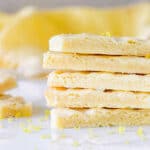
Lemon Shortbread (buttery and easy)
This shortbread is a glorious mix of butter, sugar, flour, and enough lemon flavor to cut through that buttery amazingness. The dough can be refrigerated for a day before baking and the baked shortbread keeps very well.
Servings 16 sticks
Ingredients
- ¾ cup unsalted butter at room temperature
- 1 ¼ cups all-purpose flour or cake flour
- pinch of salt
- 2 tablespoons lemon zest see Notes below for extra lemon flavor
- ⅛ teaspoon vanilla extract drops, literally
- ½ cup powdered sugar sifted
- 1 tablespoon granulated sugar for topping
Instructions
- Have ready a 9-inch (20x20cm) square baking pan that has been buttered or sprayed with baking spray.
- Line it with parchment paper: take a large piece of parchment paper of about 8 inches (almost as wide as the pan) and cover the bottom and two sides of the pan. The other two sides will remain buttered but not lined with paper. This will help you remove the shortbread after it's baked.
- In a large bowl, mix ¾ cup unsalted butter with 2 tablespoons lemon zest (I zest it directly over the butter mixture using a microplane zester) and ⅛ teaspoon vanilla extract.
- Add ½ cup powdered sugar and incorporate well so there are no lumps. I recommend sifting the sugar before adding it, or sifting it directly over the butter mixture as I do.
- Add 1 ¼ cups all-purpose flour and pinch of salt in 2 parts, mixing with the spatula until it is smooth, well combined and no dry spots remain.
- Transfer the dough to the prepared pan, scattering small amounts on the bottom.
- Lightly pat the dough with your hand until it covers the whole surface. Make sure the edges are covered. Make it as even as possible, but relax because it will not be completely smooth.
- Refrigerate the whole pan, covered in plastic wrap, for at least 1 hour (and up to 24 hours). You can bake it directly, but this resting time creates a more tender shortbread, in my experience.
- Preheat the oven to 325°F (160°C).
- Sprinkle 1 tablespoon granulated sugar over the top before baking.
- Bake the shortbread for 40-45 minutes, until the top is dry, has puffed slightly and is beginning to color. You can leave it a few more minutes for a more golden shortbread. Just don’t let it dry out.
- Let cool for 10 minutes on a wire rack and carefully score (cut but not all the way through) into sticks, squares or triangles with a smooth-bladed knife.
- Let cool on the cooling rack completely, lift the whole square of the pan with the aid of the parchment paper, and carefully separate each piece. It keeps well for a week or more after you cut it, so it's great for gift-giving. Always use an airtight container, ideally a metal one or a jar.
Notes
Baking time: keep in mind that all ovens and pans are different, even if they look the same or very similar. The baking time in my recipes is as accurate as it can be, but it might take you more or less time. You can use a thermometer that is placed inside the oven to check that your oven is at the right temperature. I recommend you keep track of how your oven works and what tiny details you might need to adjust.
Is the resting period needed? You can bake it directly, but the refrigeration time makes for a more tender, melt-in-your-mouth shortbread. I think it's worth the wait, but you should adjust recipes to your own timeline and palate.
Extra lemon flavor: you can add lemon extract, paste, or emulsion (in addition to the lemon zest) to intensify the flavor. Start with ¼ teaspoon and see how it goes as they can sometimes be intense.
Dough: once you have it patted in the pan, the unbaked shortbread can be kept for 24 hours in the fridge, or frozen for up to a month, always well wrapped. Bake directly from the freezer.